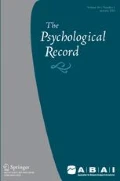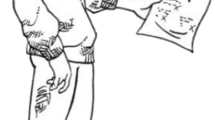Abstract
Objective: The word repetition technique is used in acceptance and commitment therapy as a method of facilitating cognitive defusion from distressing thoughts. The present study conducted a randomised trial to manipulate the rate of word repetition and evaluate its impact on the efficacy of cognitive defusion. Method: Thirty-two participants repeated a self-chosen negative self-evaluative word for 30 seconds at the rates of one word per 0.5-, 1-, or 2-seconds. Visual analogue scales were used to measure the associated levels of believability and discomfort at pre- and immediately postrepetition, and 1 month later. Results: Both believability and discomfort were significantly reduced immediately after word repetition in the 0.5-seconds and 1-second conditions. There was a significantly greater reduction in Discomfort in the 1-second condition in comparison to the 2-second condition. The 1-second condition alone maintained significant reductions in both believability and discomfort at 1-month follow up. Conclusion: Differences in the cognitive defusion of distressing thoughts appear to be influenced by word repetition rate with repetition rates of one word per 0.5 and 1 seconds somewhat more effective for treating distressing private experiences associated with problem words.




Similar content being viewed by others
References
Arch, J. J., & Craske, M. G. (2008). Acceptance and commitment therapy and cognitive behavioural therapy for anxiety disorders: Different treatments, similar mechanisms? Clinical Psychology: Science and Practice, 15, 263–279. doi:10.1111/j.1468-2850.2008.00137.x.
Arch, J. J., Eifert, G. H., Davies, C., Vilardaga, J. C. P., Rose, R. D., & Craske, M. G. (2012). Randomized clinical trial of cognitive behavioral therapy (CBT) versus acceptance and commitment therapy (ACT) for mixed anxiety disorders. Journal of Consulting and Clinical Psychology, 80, 750–765. doi:10.1037/a0028310.
Barrera, T. L., Szafranski, D. D., Ratcliff, C. G., Garnaat, S. L., & Norton, P. J. (2016). An experimental comparison of techniques: Cognitive defusion, cognitive restructuring, and in-vivo exposure for social anxiety. Behavioral and Cognitive Psychotherapy, 44, 249–254. doi:10.1177/0145445515621488.
Blackledge, J. T. (2007). Disrupting verbal processes: Cognitive defusion in acceptance and commitment therapy and other mindfulness-based psychotherapies. The Psychological Record, 57, 555–576.
Blackledge, J. T. (2015). Cognitive defusion in practice: A clinician’s guide to assessing, observing & supporting change in your client. Oakland, CA: Context Press.
Cochrane, A., Barnes-Holmes, D., & Barnes-Holmes, Y. (2008). The Perceived-Threat Behavioral Approach Test (PT-BAT): Measuring avoidance in high-, mid-, and low-spider fearful participants. The Psychological Record, 58, 585–596.
Craske, M. G., Niles, A. N., Burklund, L. J., Wolitzky-Taylor, K. B., Vilardaga, J. C. P., Arch, J. J.,…Liberman, M. D. (2014). Randomized controlled trial of cognitive behavioral therapy and acceptance and commitment therapy for social phobia: Outcomes and moderators. Journal of Consulting and Clinical Psychology, 82, 1034–1048. doi:10.1037/a0037212
Deacon, B. J., Fawzy, T. I., Lickel, J. J., & Wolitzky-Taylor, K. B. (2011). Cognitive defusion versus cognitive restructuring in the treatment of negative self-referential thoughts: An investigation of process and outcome. Journal of Cognitive Psychotherapy: An International Quarterly, 25, 218–232. doi:10.1891/0889-8391.25.3.218.
De Young, K. P., Lavender, J. M., Washington, L. A., Looby, A., & Anderson, D. A. (2010). A controlled comparison of the word repeating technique with a word association task. Journal of Behavior Therapy and Experimental Psychiatry, 41, 426–432. doi:10.1016/j.jbtep.2010.04.006.
Dymond, S., Schlund, M. W., Roche, B., De Houwer, J., & Freegard, G. P. (2012). Safe from harm: Learned, instructed, and symbolic generalisation pathways of human-threat avoidance. PLOS ONE, 7(10), e47539. doi:10.1371/journal.pone.0047539.
Eifert, G. H., & Forsyth, J. P. (2005). Acceptance and commitment therapy for anxiety disorders: A practitioner’s treatment guide to using mindfulness, acceptance, and values-based behavior change strategies. Oakland, CA: New Harbinger.
Gillanders, D. T., Bolderston, H., Bond, F. W., Dempster, M., Flaxman, P. E., Campbell, L.,…Remington, R. (2014). The development and initial validation of The Cognitive Fusion Questionnaire. Behavior Therapy, 45, 83–101. doi:10.1016/j.beth.2013.09.001
Hayes, S. C., Barnes-Holmes, & Roche, B. (Eds.). (2001). Relational frame theory: A post-Skinnerian account of human language and cognition. New York, NY: Plenum Press.
Hayes, S. C., Levin, M. E., Plumb-Vilardaga, J., Villatte, J. L., & Pistorello, J. (2013). Acceptance and commitment therapy and contextual behavioral science: Examining the progress of a distinctive model of behavioral and cognitive therapy. Behavior Therapy, 44, 180–198. doi:10.1016/j.beth.2009.08.002.
Hayes, S. C., Luoma, J. B., Bond, F. W., Masuda, A., & Lillis, J. (2006). Acceptance and commitment therapy: Model, processes and outcomes. Behavior Research and Therapy, 44, 1–25. doi:10.1016/j.brat.2005.06.006.
Hayes, S. C., Pistorello, J., & Levin, M. E. (2012). Acceptance and commitment therapy as a unified model of behaviour change. The Counselling Psychologist, 40, 976–1002. doi:10.1177/0011000012460836.
Hayes, S. C., Strosahl, K. D., & Wilson, K. G. (1999). Acceptance and commitment therapy: An experiential approach to behavior change. London, UK: Guilford Press.
Hayes, S. C., Strosahl, K. D., & Wilson, K. G. (2012). Acceptance and commitment therapy: The process and practice of mindful change. New York, NY: Guilford Press.
Healy, H. A., Barnes-Holmes, Y., Barnes-Holmes, D., Keogh, C., & Wilson, K. (2008). An experimental test of a cognitive defusion exercise: Coping with negative and positive self-statements. The Psychological Record, 58, 623–640.
Hinton, M. J., & Gaynor, S. T. (2010). Cognitive defusion for psychological distress, dysphoria, and low self-esteem: A randomized technique evaluation trial of vocalizing strategies. International Journal of Behavioral Consultation and Therapy, 6, 16–185.
Hooper, N., & McHugh, L. (2013). Cognitive defusion versus thought distraction in the mitigation of learned helplessness. The Psychological Record, 63, 1–10.
Larsson, A., Hooper, N., Osborne, L., Bennett, B., & McHugh, L. (2015). Using brief cognitive restructuring and cognitive defusion techniques to cope with negative thoughts. Behavior Modification, 40, 452–482. doi:10.1177/0145445515621488.
Losada, A., Márquez-González, M., Romero-Moreno, R., Mausbach, B. T., López, J., Fernández-Fernández, V., & Nogales-González, C. (2015). Cognitive–behavioral therapy (CBT) versus acceptance and commitment therapy (ACT) for dementia family caregivers with significant depressive symptoms: Results of a randomized clinical trial. Journal of Consulting and Clinical Psychology, 83, 760–772. doi:10.1037/ccp0000028.
Luoma, J. B., & Hayes, S. C. (2009). Cognitive defusion. In W. T. O’Donohue & J. E. Fisher (Eds.), General principles and empirically supported techniques of cognitive behavior therapy (pp. 181–188). Hoboken, NJ: John Wiley & Sons.
Luoma, J. B., Hayes, S. C., & Walser, R. (2007). Learning acceptance and commitment therapy: A skills training manual for therapists. Oakland, CA: New Harbinger.
MacLeod, C. M. (1991). Half a century of research on the Stroop effect: An integrative review. Psychological Bulletin, 109, 163–203. doi:10.1037/0033-2909.109.2.163.
Masuda, A., Hayes, S. C., Sackett, C. F., & Twohig, M. P. (2004). Cognitive defusion and self-relevant negative thoughts: Examining the impact of a ninety year old technique. Behavior Research and Therapy, 42, 477–485. doi:10.1016/j.brat.2003.10.008.
Masuda, A., Hayes, S. C., Twohig, M. P., Drossel, C., Lillis, J., & Washio, Y. (2009). A parametric study of cognitive defusion and the believability and discomfort of negative self-relevant thoughts. Behavior Modification, 33, 250–262. doi:10.1177/0145445508326259.
Masuda, A., Twohig, M. P., Stormo, A. R., Feinstein, A. B., Chou, Y., & Wendell, J. W. (2010). The effects of cognitive defusion and thought distraction on emotional discomfort and believability of negative self-referential thoughts. Journal of Behavior Therapy and Experimental Psychiatry, 41, 11–17. doi:10.1016/j.btep.2009.08.006.
Pilecki, B. C., & McKay, D. (2012). An experimental investigation of cognitive defusion. The Psychological Record, 62, 19–40.
Qualtrics. (2013). Qualtrics (Version 55297 of the Qualtrics Research Suite) [Computer software]. Provo, UT: Author.
Ritzert, T. R., Forsyth, J. P., Berghoff, C. R., Barnes-Holmes, D., & Nicholson, E. (2015). The impact of a cognitive defusion intervention on behavioral and psychological flexibility: An experimental evaluation in a spider fearful non-clinical sample. Journal of Contextual Behavioral Science, 4, 112–120. doi:10.1016/j.jcbs.2015.04.001.
Roche, B., Kanter, J. W., Brown, K. R., Dymond, S., & Fogarty, C. C. (2008). A comparison of “direct” versus “derived” extinction of avoidance. The Psychological Record, 58, 443–464.
Titchener, E. B. (1910). A text-book of psychology. New York, NY: MacMillan.
Vervoort, E., Vervliet, B., Bennett, M., & Baeyens, F. (2014). Generalization of human fear acquisition and extinction within a novel arbitrary stimulus category. PloS One, 9(5), e96569. doi:10.1371/journal.pone.0096569.
Wewers, M. E., & Lowe, N. K. (1990). A critical review of visual analogue scales in the measurement of clinical phenomena. Research in Nursing and Health, 13, 227–236. doi:10.1002/nur.4770130405.
Wilson VanVoorhis, C. R., & Morgan, B. L. (2007). Understanding power and rules of thumb for determining sample sizes. Tutorials in Quantitative Methods for Psychology, 3, 43–50.
Zarling, A., Lawrence, E., & Marchman, J. (2015). A randomized controlled trial of acceptance and commitment therapy for aggressive behavior. Journal of Consulting and Clinical Psychology, 83, 199–212. doi. 10.1037/a0037946
Zettle, R. D. (2007). ACT for depression. Oakland, CA: New Harbinger.
Author information
Authors and Affiliations
Corresponding author
Ethics declarations
Funding
This research did not receive any grant funding.
Ethical Approval
All procedures performed in studies involving human participants were in accordance with the ethical standards of the institutional research committee and with the 1964 Helsinki declaration and its later amendments or comparable ethical standards.
Informed Consent
Informed consent was obtained from all individual participants in the study.
Conflict of Interest
On behalf of all authors, the corresponding author states there is no conflict of interest.
Rights and permissions
About this article
Cite this article
Tyndall, I., Papworth, R., Roche, B. et al. Differential Effects of Word-Repetition Rate on Cognitive Defusion of Believability and Discomfort of Negative Self-Referential Thoughts Postintervention and at One-Month Follow-Up. Psychol Rec 67, 377–386 (2017). https://doi.org/10.1007/s40732-017-0227-2
Published:
Issue Date:
DOI: https://doi.org/10.1007/s40732-017-0227-2




